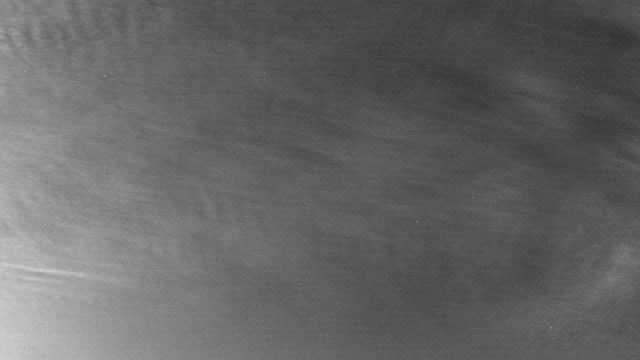Life can be stressful and full of toil. To ease your tortured mind, we present to you some stunning photographs of clouds on Mars, recently taken by NASA’s Curiosity rover.
Curiosity is currently exploring the lower regions of Mount Sharp in Gale Crater, where it’s doing some important drilling and other fun science. From May 7 to May 17, the rover snapped some cool photos of clouds overhead using its black-and-white Navigation Cameras (NavCams). Curiosity tends to take photos of the ground, so these new images are a welcome reprieve.
A NASA press release described the clouds as being of the noctilucent variety—clouds that reflect sunlight even after dusk owing to their extreme height. These clouds are likely comprised of water-ice, according to NASA. Wafting some 31 kilometers above the Martian terrain, they bear an uncanny resemblance to clouds seen on Earth. It’s a goosebump-inducing sight—these are clouds as seen from the surface of another planet. Another. Freakin’. Planet.
Far from being an idle activity, however, Curiosity’s cloud-gazing behaviour holds serious purpose. The rover is currently working in conjunction with its NASA colleague, the InSight lander, which is permanently parked some 600 kilometers away. Back in late April, InSight snapped its own photos of clouds using its Instrument Context Camera (ICC). Snapping photos of “the same clouds from two vantage points can help scientists calculate their altitude,” explained NASA.
In July 2017, Curiosity used its NavCam to capture a series of images that were used to create grainy videos showing the movement of Martian clouds (one example shown below). Unlike the noctilucent clouds recently imaged by the rover, these were cirrus clouds—thin and wispy clouds typically found at heights above 6,000 meters.
In other Martian business, Curiosity has been working at a “clay-bearing unit” that’s living up to its name. While drilling into two rock targets, “Aberlady” and “Kilmarie,” the rover uncovered the “highest amounts of clay minerals ever found during the mission,” according to NASA.
Clay is hugely important from a scientific perspective because it requires the presence of water to form, and water is essential, as far as we know, for the emergence of life. Curiosity is thus continuing to fulfil an important part of its mandate: searching for signs of prior habitability on la Planète Rouge. All this clay suggests Gale Crater was once drenched in water, the exact nature of which is still a bit of a mystery.
Speaking of mysteries, Curiosity’s mineralogy instrument, CheMin, only found scant traces of an iron oxide mineral called hematite in the samples. That’s a bit weird given its abundance to the north at Vera Rubin Ridge, Curiosity’s former stomping ground. Ah, but what would science be without the unexpected?
Upon completion of its drilling work, Curiosity struck a pose with the drill holes in clear view. The selfie was captured on May 12, 2019, and it was stitched together from 57 individual images.
Gotta say, the rover is lookin’ mighty good despite its years of service—though when I see a photo of Curiosity these days I’m struck with an overwhelming urge to brush off all the dust that’s accumulated on its deck. Hopefully a fortuitous Martian dust devil will eventually sweep by and do the honours, much like the one that recently visited the InSight lander.
